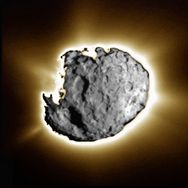 |
| A detailed analysis of the comet Wild 2 (pronounced "Vilt 2") has left astronomers astounded at an object that has no known peers in the solar system |
The comet, examined in a close flyby in January by NASA's Stardust spacecraft, has towering protrusions and steep-walled craters that seem to defy gravity. More than a dozen jets of material shoot out from its insides. Dust swirls around the comet in unexpectedly dense pockets.
A composite image of comet Wild 2 shows part of its surface detail overlain on a longer-exposure image that reveals the outgassing jets.
Among the bizarre features are two depressions with flat floors and nearly vertical walls that resemble giant footprints. They aren't structured like typical impact craters. The features have been named Left Foot and Right Foot in a new map of the comet, which is roughly 3 miles (5 kilometres) wide.
Only two other comets have been seen up close, but both appeared fairly smooth and were nowhere near so heavily cratered. Nor do the pockmarked surfaces common to asteroids and moons bear much stylistic resemblance to the shapes seen on Wild 2.
"So far, as far as we know Wild 2 is a unique object," said Donald Brownlee, an astronomy professor at the University of Washington and Stardust's principal investigator.
Brownlee told SPACE.com that Wild 2Â could represent a unique class of comet. He and his colleagues had expected it to be relatively featureless with a dusty, charcoal-like coating. Instead they found a place riddled with apparently ancient impact craters. Broad mesas and steep canyons stand out clearly.
It is more likely, Brownlee added, that Wild 2 will turn out to be a garden variety comet once more of them are studied up close.
Brownlee's group and other research teams present four analyses of Wild 2 in the June 18 issue of the journal Science, building on preliminary results released in March.
"There's almost no gravity at the surface," Brownlee said. "If you were standing on [the surface], you could jump into orbit."
Source: http://www.space.com/scienceastronomy/stardust_results_040617.html
* * *
You are welcome to print and circulate all articles published on Clearharmony and their content, but please quote the source.










 more ...
more ...